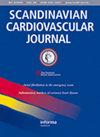ICD的危害和益处:应用于瑞典ICD治疗的LQTS人群的风险评分
IF 1
4区 医学
Q3 CARDIAC & CARDIOVASCULAR SYSTEMS
引用次数: 0
摘要
抽象的目标。在高风险的长QT综合征(LQTS)患者中使用植入式心律转复除颤器(ICDs)是必不可少的。然而,它有时用于没有高风险的患者,其预期获益可能低于ICD危害的风险。在这里,我们通过评估风险评分和ICD前的临床特征来评估ICD的利弊。设计。我们研究了109名瑞典LQTS患者,这些患者来自瑞典ICD和起搏器登记处,数据来自医疗记录。除了临床特征外,我们还使用两种风险评分来评估ICD前的风险,并评估ICD的益处和危害。结果。20%的患者接受≥1次适当休克,第一次适当休克发生率为每100人年4.3次。较长的QTc(≥550 ms)和双突变与适当的休克显著相关。无icd前心脏骤停流产患者的低风险评分与首次适当休克的低风险无显著相关性。首次不适宜性休克和首次并发症的发生率分别为3.0和7.6 / 100人年。结论。我们关于ICD危害的研究结果强调了仔细考虑ICD前个体的重要性。当我们将两个风险评分应用于没有icd前心脏骤停的患者时,我们无法验证他们识别低风险适当电击患者和低风险仍接受适当电击的患者的能力。这进一步支持了风险分层的复杂性和使用风险评分的难度。本文章由计算机程序翻译,如有差异,请以英文原文为准。
ICD harm and benefit: risk scores applied to the Swedish ICD-treated LQTS population
Abstract Objectives. The use of implantable cardioverter defibrillators (ICDs) in long QT syndrome (LQTS) patients is essential in high-risk patients. However, it is sometimes used in patients without high-risk profiles for whom the expected benefit may be lower than the risk of ICD harm. Here, we evaluated ICD benefit and harm by assessing risk according to risk scores and pre-ICD clinical characteristics. Design. We studied 109 Swedish LQTS patients drawn from the Swedish ICD and Pacemaker Registry with data collected from medical records. In addition to clinical characteristics, we used two risk scores to assess pre-ICD risk, and evaluated ICD benefit and harm. Results. Twenty percent of all patients received ≥1 appropriate shock with a first appropriate shock incidence rate of 4.3 per 100 person-years. A long QTc (≥550 ms) and double mutations were significantly associated with appropriate shock. Low risk scores among patients without pre-ICD aborted cardiac arrest were not significantly associated with low risk of first appropriate shock. The incidence rates of a first inappropriate shock and first complication were 3.0 and 7.6 per 100 person-years, respectively. Conclusion. Our findings on ICD harm emphasize the importance of careful individual pre-ICD consideration. When we applied two risk scores to patients without pre-ICD aborted cardiac arrest, we could not validate their ability to identify patients with low risk of appropriate shocks and patients who were assessed as having a low risk still received appropriate shocks. This further supports the complexity of risk stratification and the difficulty of using risk scores.
求助全文
通过发布文献求助,成功后即可免费获取论文全文。
去求助
来源期刊

Scandinavian Cardiovascular Journal
医学-心血管系统
CiteScore
3.40
自引率
0.00%
发文量
56
审稿时长
6-12 weeks
期刊介绍:
The principal aim of Scandinavian Cardiovascular Journal is to promote cardiovascular research that crosses the borders between disciplines. The journal is a forum for the entire field of cardiovascular research, basic and clinical including:
• Cardiology - Interventional and non-invasive
• Cardiovascular epidemiology
• Cardiovascular anaesthesia and intensive care
• Cardiovascular surgery
• Cardiovascular radiology
• Clinical physiology
• Transplantation of thoracic organs
 求助内容:
求助内容: 应助结果提醒方式:
应助结果提醒方式:


